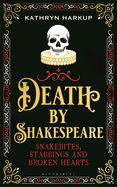
 William Shakespeare took simple ideas and wove them, with rich detail, into poetry and prose that astoundingly still resonates centuries later. Throughout much of his work, he layered in empathy and understanding about life and death.
William Shakespeare took simple ideas and wove them, with rich detail, into poetry and prose that astoundingly still resonates centuries later. Throughout much of his work, he layered in empathy and understanding about life and death.
During the 16th and 17th centuries, the grim reality of death was pervasive. The average life expectancy in England during Shakespeare's time was roughly age 38. Commonplace in the era were widespread illness, contagious disease and plagues; starvation and violent excesses; murder and suicide; venereal diseases and deaths from childbirth; witchcraft; war and public executions. With that in mind, how could Shakespeare not weave the drama of lurking death, complete with blood, gruesomeness and gore, into his stories--tragedies, histories and comedies--that played out on the Renaissance stage?
These facts drew chemist and author Kathryn Harkup (A Is for Arsenic) to explore facets of death in the Bard's dramatic works and to examine death through the detailed prism of analytical science. Did Shakespeare capture the essence of death with accuracy? Were the hangings, burnings at the stake and beheadings prevalent in his plays about Henry V and Henry VI rendered authentically? Were the poisoning in Hamlet, the snakebite that did in Cleopatra and the catastrophic emotional grief inherent in Romeo and Juliet authentic? How and where did William Shakespeare gain his knowledge and insight--and how might he have come to understand the complex vulnerabilities that lead to processes of death?
Harkup leaves no stone unturned in her immensely thorough and compelling distillation of the Bard's work, Death by Shakespeare. She starts with his humble beginnings in the 1500s and his rise to prominence, setting his ascendency amid the challenges of the time and the context of other playwrights of his era. From there, she cites specific works, examining the role of doctors, quacks and apothecaries in many of his plays, from Dr. Caius in The Merry Wives of Windsor to the female practitioner Helena who successfully treats the king of France after male physicians have failed in All's Well that Ends Well. Through an intricate dissection of Shakespearean plays, Harkup breaks down and analyzes methods of death, destruction and peril, and delves into how Elizabethan actors might have been bloodied up for battles of war using lye or slow coagulating sheep's blood; how the 33 stab wounds that murdered Julius Caesar were re-enacted on stage; and if a real skull might have been used (whose?) when Hamlet delivered his famous soliloquy.
Harkup's expertise leans toward the scientific. Her riveting storytelling, however, is refreshingly accessible. Her narrative will attract and intrigue readers who appreciate the macabre, eager for the enriching wisdom offered by two masters in their fields. --Kathleen Gerard, blogger at Reading Between the Lines
Shelf Talker: A fascinating, thorough examination and scientific analysis of notable deaths that pervade the stage works of William Shakespeare.

